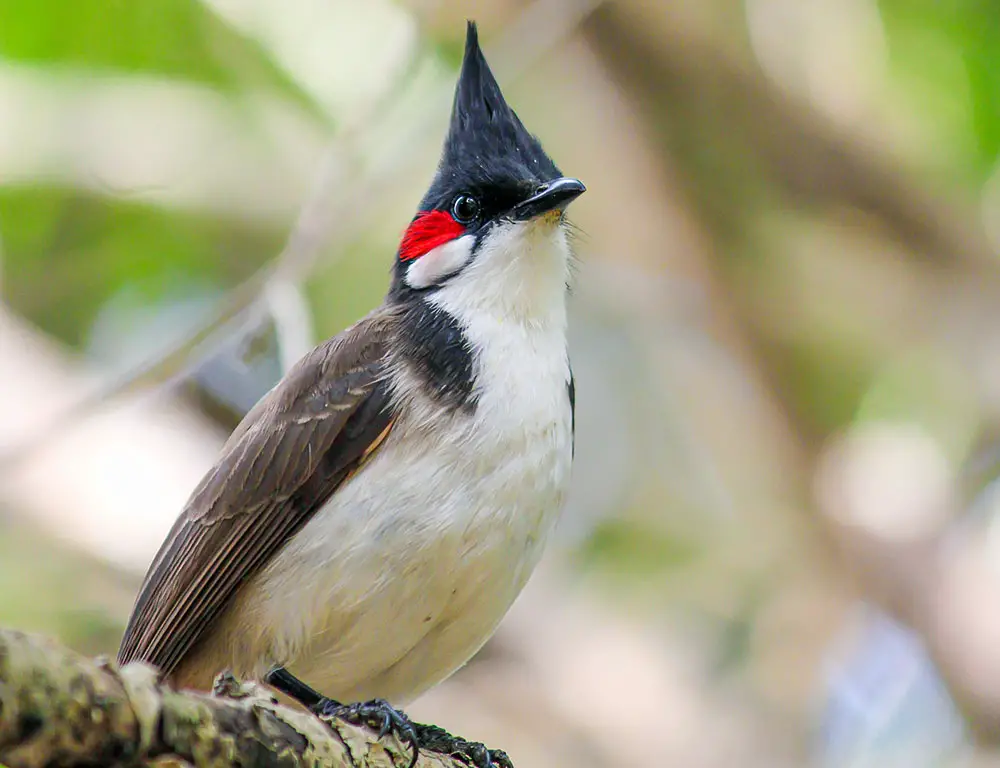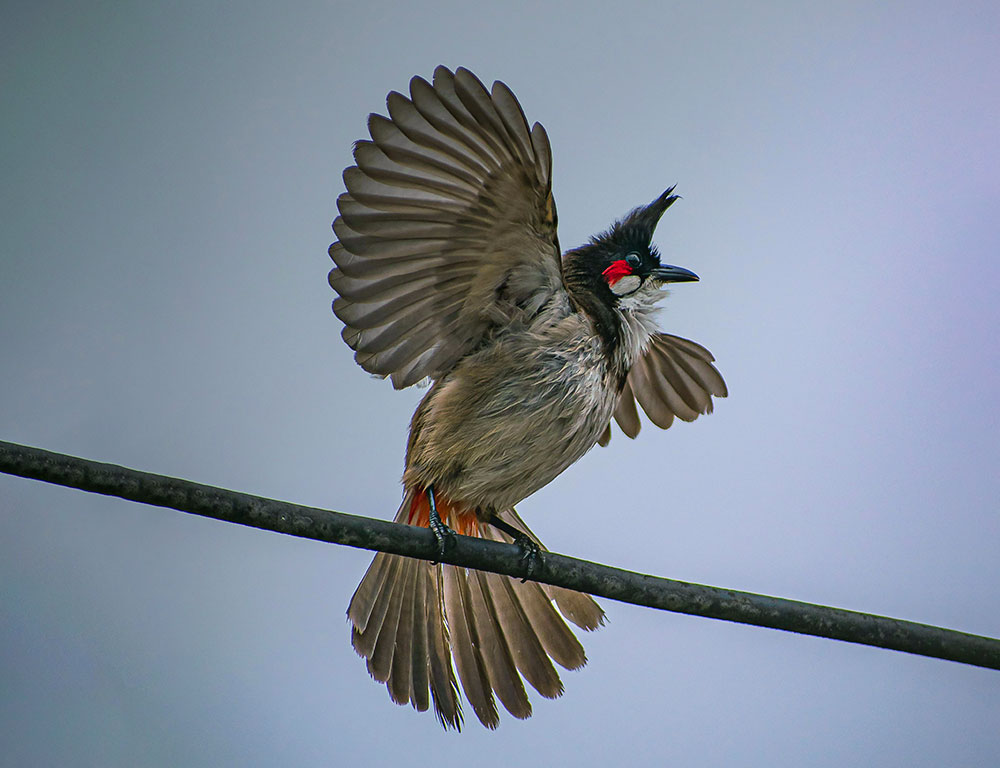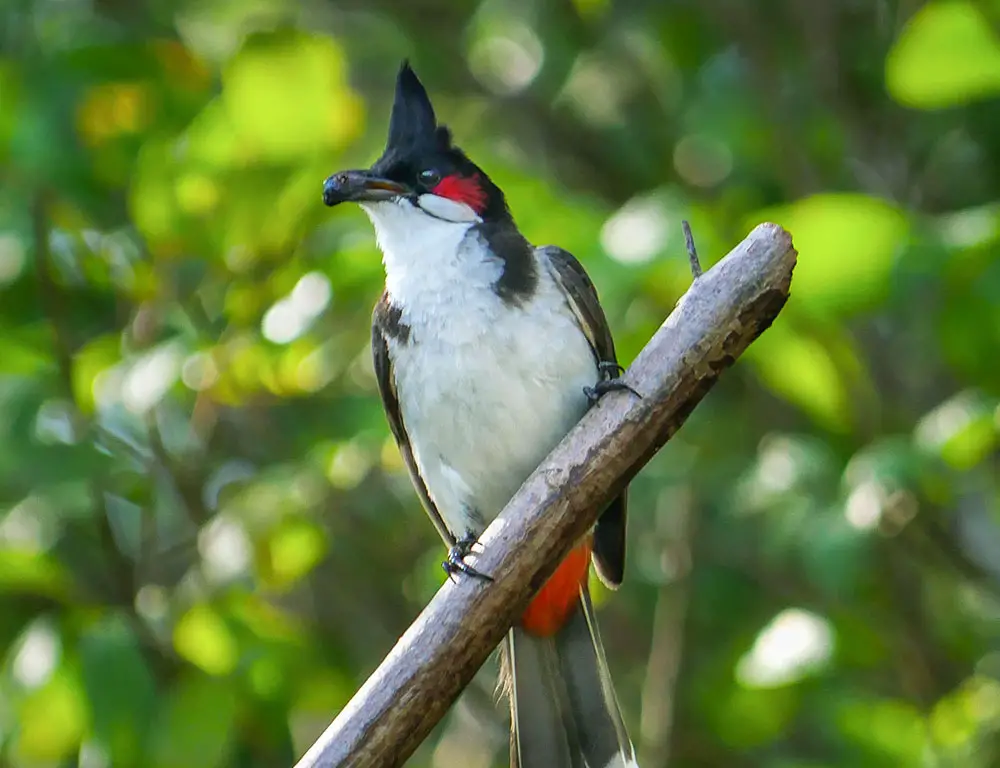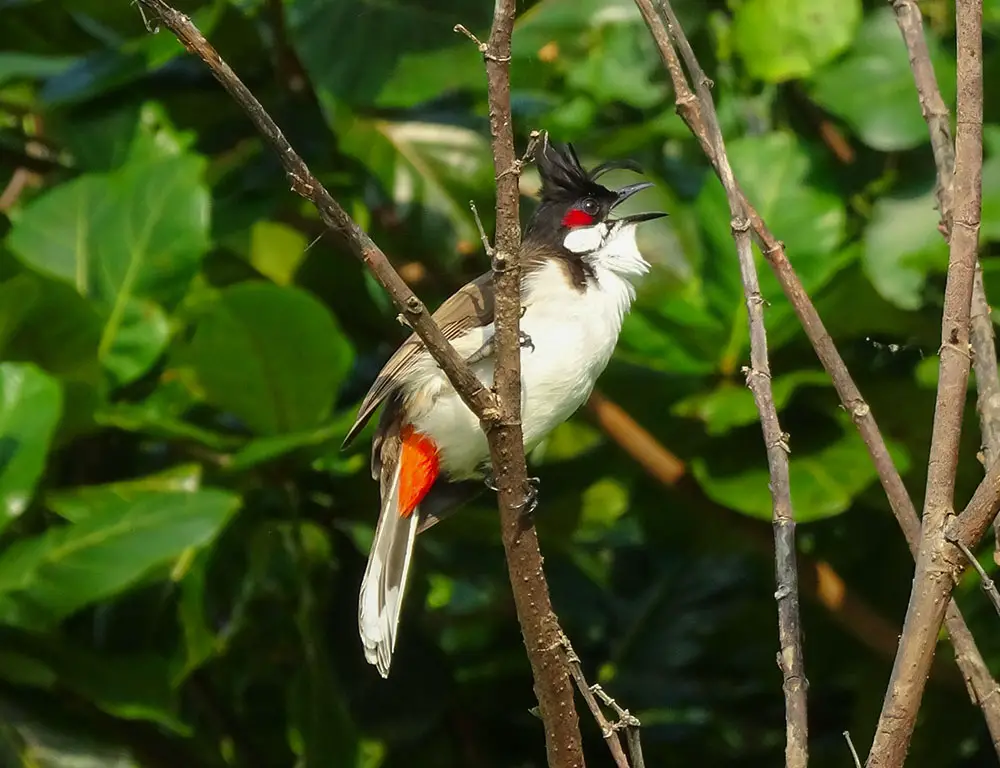The Red-Whiskered Bulbul, a vibrant bird species native to tropical Asia, has always intrigued me. Known scientifically as Pycnonotus jocosus, this striking creature boasts an impressive crest of feathers on its head and distinctive red patches under its eyes, hence the name.
You can’t miss their lively presence in the wild – they’re social creatures, often gathering in small groups.
Their melodic songs are equally enchanting, echoing throughout their habitat. They’ve adapted well to urban environments, too; it’s common for city-dwellers in certain parts of the world to spot these birds perched on rooftops or trees.
Beyond their visual appeal and charming tunes, something is fascinating about their adaptability. Despite being an ‘introduced species’ in many regions outside of Asia – that is, brought deliberately or accidentally by humans – they’ve managed to thrive remarkably well.
Their story is a compelling example of nature’s resilience amidst human-induced changes.
Physical Characteristics of the Red-Whiskered Bulbul

The Red-Whiskered Bulbul (Pycnonotus jocosus) boasts a captivating array of physical characteristics that set it apart in the avian world.
Here’s a closer look at its physical characteristics:
Size
Standing at approximately 20cm tall, the Red-Whiskered Bulbul is of moderate size compared to other bird species.
Plumage Coloration
Its plumage is predominantly brownish-black and white, creating a striking contrast. The brownish-black dominates the upperparts while the white features prominently on the underparts.
Distinctive Features
- Red Face Patch: One of its most notable features is the red face patch, which adorns its cheeks, earning it the name “Red-Whiskered” Bulbul.
- Black Crest: A thin, pointed black crest embellishes its head, adding to its distinctive appearance.
- Long Tail with White Tips: The Red-Whiskered Bulbul possesses a long tail with white tips. This tail tends to fan out when the bird is excited or agitated, adding a dramatic flair to its presence.
- Crimson Undertail Coverts: Its bright crimson undertail coverts provide a vibrant splash of color, especially noticeable during movement.
- ‘Whiskers’: The ruby-red cheeks, often called ‘whiskers,’ are a charming feature that contrasts beautifully against its pale underparts.
Behavioral Characteristics
While not strictly physical, the Red-Whiskered Bulbul’s behavior also contributes to its charm and uniqueness. They are known for their lively and active nature, often hopping around branches with agility.
Habitat and Distribution of the Red-Whiskered Bulbul

The Red-Whiskered Bulbul (Pycnonotus jocosus) is a versatile bird in habitat and distribution.
Here’s a breakdown of its habitat preferences and distribution:
Geographical Distribution
- Native Range: The Red-Whiskered Bulbul is native to tropical regions of Asia, including India, Nepal, Bangladesh, and Myanmar. These areas provide the primary habitats where these birds thrive naturally.
- Introduced Populations: Due to human activities such as introductions and escapes from captivity, Red-Whiskered Bulbuls have also established populations in non-native regions.
For instance, they can be found in urban areas of cities like Miami and Los Angeles in the United States. Australia also hosts populations of introduced Red-Whiskered Bulbuls.
Habitat Preferences
- Forests: Within their native range, Red-Whiskered Bulbuls prefer forested areas. Dense vegetation in forests provides suitable nesting sites and shelters from predators.
- Urban Gardens and Parks: Interestingly, these birds have adapted well to urban environments. They can often be found in cities’ gardens, parks, and other green spaces.
This adaptability to urban areas contributes to their widespread presence even in densely populated regions. - Hill Slopes and Tree-tops: In countries like Nepal, Red-Whiskered Bulbuls inhabit hill slopes and frequent the upper branches of trees.
- Fruit Trees: Red-whiskered Bulbuls have a particular affinity for fruit trees. The presence of fruit trees in their habitat is an intense attractant, providing food and potential nesting sites.
Behavior and Diet of the Red-Whiskered Bulbul

The Red-Whiskered Bulbul, a charismatic bird known for its friendly nature and diverse diet, exhibits intriguing behaviors and feeding habits contributing to its survival and role in its ecosystem.
Social Behavior
Red-whiskered bulbuls are highly social birds often found in pairs or small groups. Their agile movements and graceful flights through the tree canopy reflect their active and gregarious nature.
Their melodious calls, especially during the early morning and late evening, serve as a means of communication and a display of their presence within their habitat.
Dietary Preferences
- Fruits (50%): Red-whiskered bulbuls are fond of various fruits, constituting a significant portion of their diet. Their consumption of fruits contributes to seed dispersal, making them valuable contributors to the ecosystem’s dynamics.
- Insects (30%): With their agile flight and keen eyesight, Red-Whiskered Bulbuls adeptly hunt insects, utilizing quick darting flights to capture their prey. Insect consumption provides essential protein and nutrients, particularly during the breeding season when energy demands are high.
- Berries (20%): Berries also form a part of the bulbul’s diet, offering additional nutritional diversity. Their consumption of berries may also aid in seed dispersal, contributing to the regeneration of plant species within their habitat.
Feeding Behavior
The Red-Whiskered Bulbul’s feeding behavior is marked by versatility and agility. When feeding on fruits or berries, they demonstrate remarkable flexibility by hanging upside-down from branches to access their meal.
This behavior showcases their adaptability and resourcefulness in acquiring food.
Breeding Behavior
During the breeding season, Red-Whiskered Bulbuls construct deep cup nests where females lay 2-3 eggs at a time. Notably, both parents share incubation duties, highlighting their cooperative breeding strategy.
This shared parental care ensures the offspring’s well-being and enhances breeding success.
Conservation Status of the Red-Whiskered Bulbul

The conservation status of the Red-Whiskered Bulbul (Pycnonotus jocosus) is currently categorized as “Least Concern” on the International Union for Conservation of Nature (IUCN) Red List. However, this designation does not imply that their well-being can be disregarded.
Let’s examine the factors influencing their conservation status and the potential threats they face:
Population Trend
The population trend of the Red-Whiskered Bulbul has been reported as stable in recent years, according to data from 2016 and 2020. This stability is encouraging for the species.
Threats
- Invasive Species: Introducing invasive predators, such as cats or snakes, pose significant threats to nests and young Red-Whiskered Bulbuls. These predators can prey upon the birds or their eggs, impacting reproductive success.
- Habitat Loss: Urban development and deforestation are significant concerns for the species. As urban areas expand and forests are cleared for agriculture or industry, the natural habitats of Red-Whiskered Bulbuls are diminished, leading to habitat fragmentation and loss.
- Climate Change: The effects of climate change, including alterations in weather patterns, can disrupt food availability and breeding cycles for Red-Whiskered Bulbuls. These changes may impact their ability to raise offspring and maintain healthy populations successfully.
Conservation Efforts
Conservation efforts focused on habitat preservation and restoration are essential for ensuring the long-term survival of Red-Whiskered Bulbuls. Protecting and managing their natural habitats, as well as controlling the spread of invasive species, are crucial strategies.
Additionally, raising awareness about the importance of biodiversity conservation and promoting sustainable development practices can help mitigate the threats facing Red-Whiskered Bulbuls and other wildlife species.
Conclusion
The journey into the world of the Red-Whiskered Bulbul has been both enlightening and enchanting.
Originating from Asia, these birds have demonstrated remarkable adaptability, establishing themselves in various parts of the world, like Florida and Australia.
Their vibrant appearance, characterized by striking red cheeks and melodic songs, captures the imagination of all who encounter them. Their omnivorous diet is remarkable, allowing them to thrive in diverse environments.
From their captivating presence to their ecological flexibility, the Red-Whiskered Bulbul remains a testament to the beauty and resilience of nature.
As we bid farewell to this exploration, let’s carry forward our appreciation for these charming birds and the wonders of the natural world they embody.